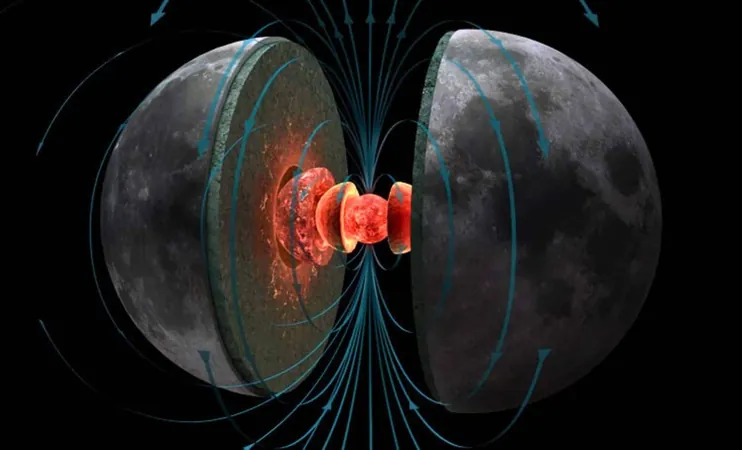
The Moon’s Middle Age Surprise: Unveiling the Secrets of a Hidden Magnetic Past!
2025-01-05
Author: Ying
For years, the consensus among scientists was that the Moon was a barren, lifeless body, stripped of a magnetic field. However, a remarkable discovery by China's Chang’e 5 mission has shattered this long-held belief, suggesting that the Moon retained a magnetic field well into its midlife. This groundbreaking revelation could dramatically alter our understanding of lunar history and forge new paths for resource exploitation on our celestial neighbor.
Chang’e 5: A Gateway to Ancient Mysteries
Launched in December 2020, the Chang’e 5 mission represented an extraordinary leap in lunar exploration, returning with the first samples from the Moon in 44 years. The mission successfully retrieved 3.82 pounds (1,731 grams) of lunar material from the Moon’s Oceanus Procellarum, particularly near the volcanic Mons Rümker region. Scientists were astounded to discover weakly magnetized rocks dated to around 2 billion years old, contradicting the long-held theory that the Moon had lost its magnetic field billions of years prior.
In a study published in *Science Advances* on January 1, 2025, a team led by Shuhui Cai from the Chinese Academy of Sciences analyzed these lunar samples, detecting a magnetic field strength ranging between 2,000 and 4,000 nanoteslas. This observation stands in stark contrast to the Moon’s present-day absence of a global magnetic field.
Key Findings from Chang’e 5:
- **Age of Samples:** The analyzed rocks, dated to 2 billion years ago, confirm the existence of a prolonged dynamo effect, suggesting a longer-lived magnetic presence.
- **Precise Magnetism Measurement:** Advanced techniques were employed to ensure accuracy, compensating for any potential contamination during the sampling process.
Additionally, data from previous Chang’e 5 studies illuminated the Moon's volcanic activity, which was surprisingly active as recently as 125 million years ago.
The Moon's Magnetic History: What We’ve Learned
Planetary magnetic fields typically develop through a dynamo effect, created by the interplay of a planet's rotation and a fluid, convecting core. Early in its history, the Moon likely possessed such a system, driven by the gravitational influence of Earth. However, as it cooled and solidified over millions of years, this dynamo effect began to wane.
Currently, the Moon has only small, localized magnetic anomalies, like the Reiner Gamma swirl—a striking 120-mile-long feature in Oceanus Procellarum. These anomalies might be vestiges of a once-universal magnetic field, suggesting that the magnetic field continued into the Moon’s midlife, enriching our understanding of its internal dynamics and geological history.
Implications for Water and Future Lunar Missions
The existence—or lack thereof—of a magnetic field can significantly impact the Moon's environmental conditions. Without a magnetic shield, solar wind particles bombard the surface, leading to the formation of critical compounds such as hydroxyls, water molecules, and Helium-3. These resources are crucial for future lunar missions and potential habitation.
However, if the Moon had retained its magnetic field longer than previously thought, then interactions with solar wind—and consequently the generation of water—might have been less prevalent. This insight raises urgent questions regarding future missions, like NASA’s Artemis program, which intends to utilize lunar water for sustainable exploration.
Potential Consequences:
- **Scarcity of Water:** The quantities of frozen water in lunar polar regions may be significantly less than expected, necessitating a shift in mission strategies.
- **Helium-3 Abundance:** The anticipated reserves of Helium-3, a promising fusion energy source, may also be lower than previously predicted, complicating future energy plans for lunar colonies.
The Moon's unexpected magnetic continuity not only reshapes its geological narrative but also compels a reevaluation of its resource viability. As ongoing missions from NASA, China, and other nations aim for lunar exploration, the Moon continues to unveil surprises that could redefine the future of space exploration.
Stay tuned—what other mysteries does the Moon have in store for us? Join the conversation!



 Brasil (PT)
Brasil (PT)
 Canada (EN)
Canada (EN)
 Chile (ES)
Chile (ES)
 Česko (CS)
Česko (CS)
 대한민국 (KO)
대한민국 (KO)
 España (ES)
España (ES)
 France (FR)
France (FR)
 Hong Kong (EN)
Hong Kong (EN)
 Italia (IT)
Italia (IT)
 日本 (JA)
日本 (JA)
 Magyarország (HU)
Magyarország (HU)
 Norge (NO)
Norge (NO)
 Polska (PL)
Polska (PL)
 Schweiz (DE)
Schweiz (DE)
 Singapore (EN)
Singapore (EN)
 Sverige (SV)
Sverige (SV)
 Suomi (FI)
Suomi (FI)
 Türkiye (TR)
Türkiye (TR)
 الإمارات العربية المتحدة (AR)
الإمارات العربية المتحدة (AR)